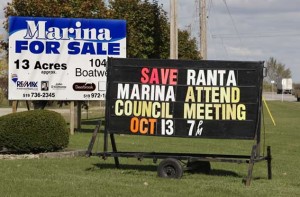Over the past several months, we’ve been approached by multiple groups that are interested in buying troubled marinas. Their selection and investment patterns differ, but there are several important threads running through each deal. One is buying them for 50 to 60 cents on the dollar. They’re willing to pay cash so a deal can close much quicker, which is important for a troubled asset.
 A second thread is that they’ll pay 50 to 60 cents based on the last appraisal. As the great Bard once said, “therein lies the rub”. The last appraisal was likely during peak economic conditions with marina financing more plentiful, a very low availability of marinas for sale and stronger marina market conditions. Was the last appraisal accurate even then? Many acquisition people I’ve spoken to say they thought the marina was over appraised at that time, yet they are basing their purchase decisions and negotiating from the ceiling of the last appraisal.
A second thread is that they’ll pay 50 to 60 cents based on the last appraisal. As the great Bard once said, “therein lies the rub”. The last appraisal was likely during peak economic conditions with marina financing more plentiful, a very low availability of marinas for sale and stronger marina market conditions. Was the last appraisal accurate even then? Many acquisition people I’ve spoken to say they thought the marina was over appraised at that time, yet they are basing their purchase decisions and negotiating from the ceiling of the last appraisal.
That leaves three questions yet to be answered. First, are they getting a good deal? Second, are they getting a good enough deal? Third, do you expect the marina’s cash flow to be the same as when the appraisal was performed and boaters don’t feel some stigma to the marina’s slow failing? Let’s do some math to find out.
Let’s say a marina was appraised for $5 million three years ago. It had a cap rate of 8 percent when it was appraised, so the net operating income was $400,000 ($5 million x 0.08). So we buy it for 60 cents on the appraised dollar or $3 million. Do we make an instant $2 million or a 66.67 percent return on investment? Let’s find out.
The first change is that even though rates may have gone up a little two years ago, they probably didn’t go up the year after or this year. Simple supply/demand. Other than top tier marinas, all other market tiers seem to be taking hits. So maybe income went up a little, but it’s likely that wages, utilities and other expenses went up by more than income. If there was boat repair income, that number is way down. I won’t even discuss boat sales revenue. Restaurant income was down too, if it was present. So let’s say our net operating income has dropped to $360,000, which is 10 percent (with boat repair and/or a restaurant present); I’m being optimistic. Of course, that assumes that the accounting was accurate.
The second change is that the 8 percent cap rate just does not apply anymore. With hundreds of marinas currently available for sale, supply exceeds demand. So let’s say the cap rate is now a more realistic 11 percent. When we do the math now, the $360,000 net operating income divided by an 11 percent cap rate equals a market value of $3,273,000. So what we really made was $273,000 on a $3 million investment or 9.10 percent.
Given the volatility in the stock market, that sounds great, right? Maybe. The way I view it, if the market cap rate for this market tier marina is 11 percent, that means that any income above $330,000 is profit ($3 million x 0.11). Well, if income drops by only $30,000, there goes the investment. Since marinas are operating businesses with payroll and insurance premiums that you can expect to see increase due to the financial failure of some large insurance companies, it would not take much to eat up that profit. If next summer was not a good year, there goes the investment. What I am getting at is there are a lot of variables that can render profitability insufficient because the marina was bought for too high a price even for 60 cents on the dollar! With “upside potential” rendered useless and the constraints of the economy and perhaps high fuel prices again, there is little that can move the ceiling but a lot that can move the floor!
And now for the million dollar question… what were the return on investment expectations of the group? If they were greater than 9.10 percent, I wouldn’t want to be at that board meeting! And if even this return was not met the first year? Now you know that the true cost of an appraisal is not the fee. It’s called opportunity cost.
‘Just my 60 cents worth… based on the value of a dollar three years ago.

